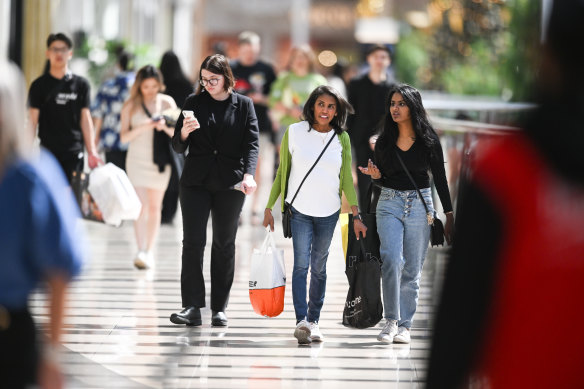By Emma Koehn
Australians under the age of 35 are feeling the heat from rising living costs the most, forcing them to cut back on discretionary spending as many older consumers keep shopping, new data shows.
The Commbank iQ Cost of Living Insights report released on Wednesday crunched data from 7 million Commonwealth Bank customers. It reveals consumers in their early 30s are under the most financial pressure as inflation and interest rates continue to rise.

The rising cost of living is putting more pressure on young renters and home owners as they try to balance their spending habits.Credit: Joe Armao
Analysis of the consumer data by the Commonwealth Bank and Quantium shows that year-on-year spending for people aged under 35 increased by just 3.4 per cent between the first quarter of 2022 and the first quarter of 2023 – below the inflation figure of 7 per cent.
Under 35s cut their spending on clothing, shoes and accessories by 8.4 per cent in the first quarter of 2023, while expenditure on retail services, such as haircuts and beauty treatments, dropped by 0.6 per cent.
Over the same time period, consumers aged over 35 increased their apparel spending by 3.5 per cent, while their retail services spending jumped by 9.7 per cent.
Consumers aged older than 55 also posted year-on-year increases in their overall spending of 7.7 per cent, tracking above inflation.
CommBank iQ head of innovation and analytics Wade Tubman said that, while many young Australians between 18 and 24 had the benefit of living at home, housing costs were putting pressure on consumers in their late 20s and early 30s.
“Renters are experiencing significant pressure. Rents are increasing by some of the highest amounts they have in some time,” he said.
Older singles and couples, meanwhile, have shown they can keep increasing their spending in areas like apparel, Tubman said.
“The take-out is that different are groups are feeling these issues differently,” he said.
Despite many households feeling the pinch, the spending data also shows Australians, overall, are prioritising discretionary spending and experiences, even as inflation continues to rise.
Overall, consumers spent 39 per cent more on travel in the first quarter of this year compared with the first quarter of 2022, while spending on eating out and food delivery jumped 8.5 per cent.
Meanwhile, spending on so-called essential goods is barely keeping up with inflation.
Tubman says the surprising figures suggest Australians are willing to cut back on everyday essentials to make sure they can have the experiences they were denied during the COVID years.
The numbers are another warning bell for companies in the retail and home goods sector, who benefitted from young families spending up big during COVID lockdowns over the past few years.
Australian Bureau of Statistics figures for March show household goods retail turnover dropped by 0.4 per cent in March, while clothing and footwear sales were down by 1 per cent.
A recent consumer survey from investment bank UBS also highlighted that while wealthy consumers were still upbeat about their spending intentions for the year ahead, low- and middle-income earners were under increasing pressure and taking a more conservative approach to spending.
The Business Briefing newsletter delivers major stories, exclusive coverage and expert opinion. Sign up to get it every weekday morning.